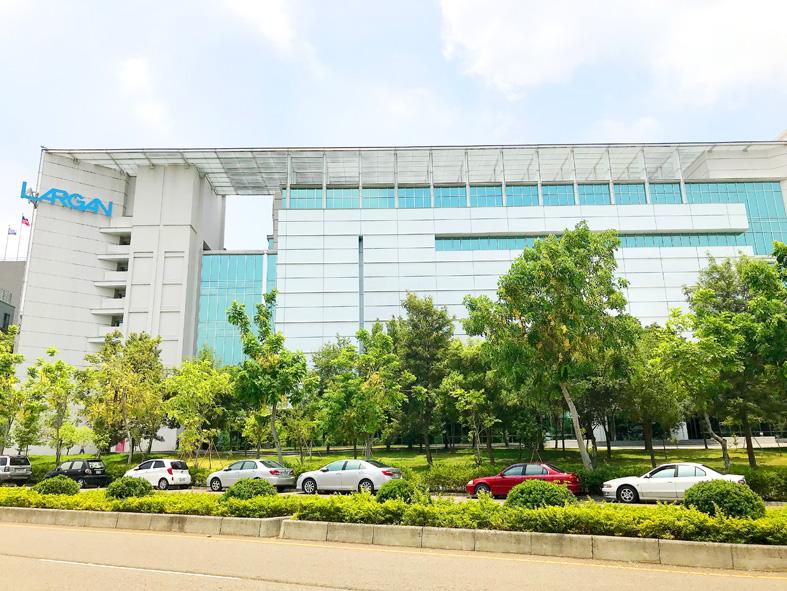Last month’s revenue at Largan Precision Co (大立光) was the highest the smartphone camera lens supplier had posted in 10 months and marks the sixth consecutive month of growth, the company said yesterday.
Consolidated revenue rose 3.54 percent month-on-month to NT$4.35 billion (US$156.9 million), the highest since January, when the company posted NT$4.61 billion in revenue, Largan data showed.
The results reflected that the firm was ramping up production as the industry enters its peak season and customers launch new models.

Photo: Chen Mei-ying, Taipei Times
However, last month’s figure was 16.94 percent lower than the NT$5.24 billion it posted a year earlier, as component shortages and continued effects of the COVID-19 pandemic prompted smartphone brands to postpone camera upgrades, Largan said.
Analysts said that the company’s Chinese clients remained unable to make up for the loss of orders from Huawei Technologies Co (華為), which is affected by US sanctions that also influenced Largan’s average selling prices and shipping volume.
Taichung-based Largan counts Apple Inc, Sony Corp and Samsung Electronics Inc among its customers.
High-margin lenses for cameras of 20 or more megapixels accounted for 10 to 20 percent of its total shipments last month, lenses for products of 10 megapixels or more contributed 50 to 60 percent, lenses for 8-megapixel products made up 10 percent and other lenses for products with lower resolutions contributed 20 to 30 percent, Largan’s shipment breakdown showed.
As a leading maker of optical lens modules, Largan also produces real-image viewfinders and other optoelectronic parts.
The company’s cumulative revenue for the first 11 months of this year dropped 16.79 percent year-on-year to NT$42.46 billion.
Largan remains a leader in the lens industry, but the overall smartphone supply chains are still facing uncertainties amid tight supply for some components and the lingering pandemic in the near term, analysts said.
For this quarter, Largan’s revenue is forecast to grow 9 percent quarter-on-quarter, but fall 15 percent year-on-year to NT$13 billion, due mainly to its US clients losing market share, price pressure and weaker demand from Android-based smartphone brands, Yuanta Securities Investment Consulting Co (元大投顧) said in a research note last month.
Due to slowing specification upgrades, rising competition from rivals and continued pressure on its gross margin, Largan shares have declined 37.56 percent so far this year.
The shares closed 0.99 percent lower at NT$1,995 on Friday in Taipei trading, Taiwan Stock Exchange data showed.
Largan’s board of directors on Oct. 25 approved the company’s first buyback program for two months, aiming to buy back up to 1.342 million shares — or 1 percent of its outstanding shares — on the open market from Oct. 26 to Dec. 24 at NT$2,025 to NT$3,300 per share.
The company has thus far repurchased 580,000 shares for NT$2,090 on average, spending a total of NT$1.21 billion, its regulatory filings showed.

Application-specific integrated circuit designer Faraday Technology Corp (智原) yesterday said that although revenue this quarter would decline 30 percent from last quarter, it retained its full-year forecast of revenue growth of 100 percent. The company attributed the quarterly drop to a slowdown in customers’ production of chips using Faraday’s advanced packaging technology. The company is still confident about its revenue growth this year, given its strong “design-win” — or the projects it won to help customers design their chips, Faraday president Steve Wang (王國雍) told an online earnings conference. “The design-win this year is better than we expected. We believe we will win

Intel Corp chief executive officer Lip-Bu Tan (陳立武) is expected to meet with Taiwanese suppliers next month in conjunction with the opening of the Computex Taipei trade show, supply chain sources said on Monday. The visit, the first for Tan to Taiwan since assuming his new post last month, would be aimed at enhancing Intel’s ties with suppliers in Taiwan as he attempts to help turn around the struggling US chipmaker, the sources said. Tan is to hold a banquet to celebrate Intel’s 40-year presence in Taiwan before Computex opens on May 20 and invite dozens of Taiwanese suppliers to exchange views

Chizuko Kimura has become the first female sushi chef in the world to win a Michelin star, fulfilling a promise she made to her dying husband to continue his legacy. The 54-year-old Japanese chef regained the Michelin star her late husband, Shunei Kimura, won three years ago for their Sushi Shunei restaurant in Paris. For Shunei Kimura, the star was a dream come true. However, the joy was short-lived. He died from cancer just three months later in June 2022. He was 65. The following year, the restaurant in the heart of Montmartre lost its star rating. Chizuko Kimura insisted that the new star is still down

While China’s leaders use their economic and political might to fight US President Donald Trump’s trade war “to the end,” its army of social media soldiers are embarking on a more humorous campaign online. Trump’s tariff blitz has seen Washington and Beijing impose eye-watering duties on imports from the other, fanning a standoff between the economic superpowers that has sparked global recession fears and sent markets into a tailspin. Trump says his policy is a response to years of being “ripped off” by other countries and aims to bring manufacturing to the US, forcing companies to employ US workers. However, China’s online warriors